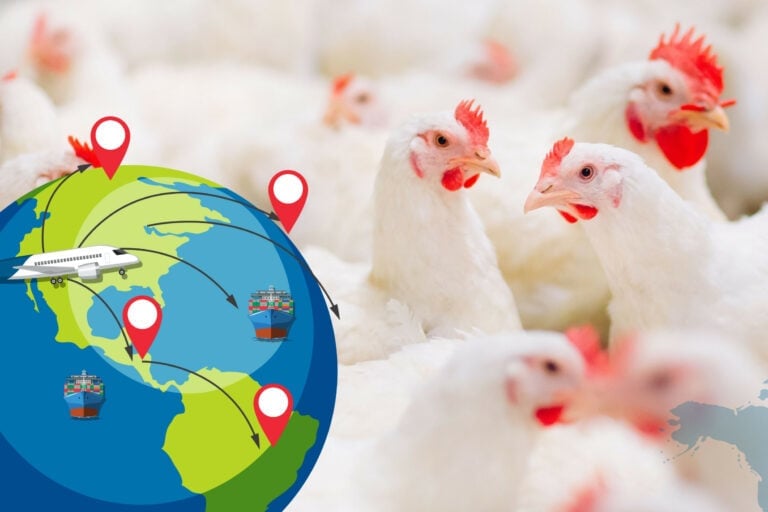November 13, 2025 | 21:17 GMT +7
November 13, 2025 | 21:17 GMT +7
Hotline: 0913.378.918
November 13, 2025 | 21:17 GMT +7
Hotline: 0913.378.918

Chicken markets are expected to remain robust through 2025. Photo: Canva.
Global poultry trade surged to record highs in the first quarter of 2025, marking a strong start to the year. But mounting challenges threaten to disrupt this momentum. A wave of avian influenza outbreaks, coupled with looming tariffs and geopolitical tensions — including potential fallout from the Israel-Iran conflict — could reshape trade flows. Already, Brazil’s avian influenza crisis has rattled markets, with key importers blocking around 40% of the country’s poultry exports.
“This uncertain economic outlook is negatively impacting markets. Therefore, we have lowered our global production forecast for 2025 from 2.5-3% growth to 2-2.5% growth, and this will likely be reduced further if the Israel-Iran war continues to escalate,” said Nan-Dirk Mulder, senior analyst of animal protein at RaboResearch.
Avian influenza
Avian influenza continues to send shockwaves through the global poultry industry following major outbreaks in the US, the EU, and Brazil. In March and April, a surge in cases hit Central Europe hard, with Poland, Hungary, and northern Italy among the worst affected. Meanwhile, the outbreak in Brazil’s Rio Grande do Sul has dealt another serious blow to global trade, given the country’s key role as a top poultry exporter.
The egg industry has taken a major hit in the US, with prices soaring to record highs in the first quarter. In Europe, avian influenza outbreaks among parent stock flocks are putting further strain on an already tight hatching egg market, delaying restocking efforts across the poultry sector. Prices for chicken, duck, and eggs have surged to historic levels, with Poland seeing some of the biggest disruptions due to widespread culling on parent stock farms. The supply crunch is intensifying across Europe and beyond, raising concerns over the industry’s ability to recover in the short term.
Trade tensions
China, Southeast Asia, and Africa face the most uncertain outlooks in global poultry trade. These regions have been hit with the highest tariffs, and the direction of future trade policies could bring significant — and widely different — consequences for their local chicken industries.
“In Southeast Asia, there is an additional worry that US import tariffs on seafood could increase local supply, indirectly affecting local poultry markets,” noted Mulder. Rising geopolitical tensions, particularly the Israel-Iran conflict, are adding another layer of volatility to global markets. Meanwhile, the ongoing US trade war could unfold in one of two ways: a full-scale global trade conflict involving sweeping tariffs and retaliatory measures, or the signing of bilateral agreements that could boost US poultry exports and investment. Either path would carry major implications for the global poultry industry.
Geopolitics and disease remain key wild cards
Chicken markets are expected to remain robust through 2025, supported by strong fundamentals and steady feed costs, which are projected to stay flat or trend slightly upward. Poultry remains well-positioned overall, but the industry’s outlook is far from certain. Much will depend on the evolution of US import tariffs and the global trajectory of avian influenza.
The Middle East, accounting for around 20% of global poultry trade, is a critical importing region. Any escalation of the Israel-Iran conflict could significantly disrupt trade flows and weigh heavily on both global poultry markets and the broader economy.
(Poultryworld)

(VAN) Malaysian durians are gaining worldwide recognition, from China to Europe and the U.S,, as exports have surged in recent years, driven by rising demand.

(VAN) Value chain linkages are becoming a key solution to enhance the competitiveness of Vietnamese agricultural products, improve climate resilience and strengthen their position in the global supply chain.

(VAN) From humble local delicacies, many businesses in the Mekong Delta have successfully conquered domestic and international markets with their distinctive One Commune One Product (OCOP) goods, contributing to sustainable rural economic development.

(VAN) The Vietnamese tilapia industry is only in the initial stages of export, yet its growth potential remains vast. To reach further, it needs to focus on breed stock, technology, and deep processing.
/2025/11/08/3402-1-212706_176.jpg)
(VAN) Viet Nam's fruit and vegetable exports continued to reach an extremely high turnover in October. With this growth momentum, the sector is expected to set a new milestone of USD 8.5 billion in 2025.
/2025/11/08/4950-1-163820_289.jpg)
(VAN) During the 2021–2025 period, Viet Nam's agro-forestry-fishery processing industry has made remarkable progress, achieving an average growth rate of 8%/year.

(VAN) Over 80 years, Vietnamese rice has journeyed through half a century to become a symbol of knowledge, resilience, and the new nation’s agriculture stature.